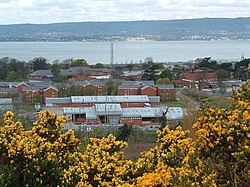History
Palace Barracks occupies the site of a palatial house known as "Ardtullagh", the home of the Bishop of Down, Connor and Dromore until it was bought by the UK War Office in 1886. [1]
In 1933, five children of Lance Corporal Harry Poole and his wife, Mary, lost their lives from asphyxiation following gas poisoning in the married quarters of the barracks. [2]
During the roughly three decades of "The Troubles" in Northern Ireland, the barracks served as the home base for battalions rotating through the province, especially those on a two-year "accompanied" tour with their families. A wide variety of facilities are available for soldiers to use off duty, including a swimming pool, squash courts, saunas, bars and a gymnasium. [3]
Palace Barracks became the Regimental Headquarters of the Royal Irish Regiment in 2008. [4]
In March 2010, it was the site of a bombing. [5] An elderly man was blown off his feet and had to be treated in hospital. The bomb was allegedly driven towards the base in a hijacked taxi. [6] The Real IRA claimed responsibility for the attack. [7]
In 2014, it became the base for the Royal Scots Borderers, 1st Battalion, The Royal Regiment of Scotland. [8]
In November 2021, 1 SCOTS was disbanded, and reformed to become 1st Battalion, Ranger Regiment. [9] [10]
This page is based on this
Wikipedia article Text is available under the
CC BY-SA 4.0 license; additional terms may apply.
Images, videos and audio are available under their respective licenses.

